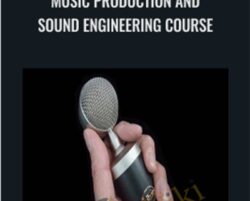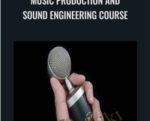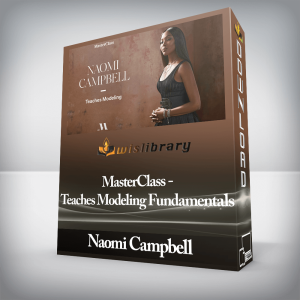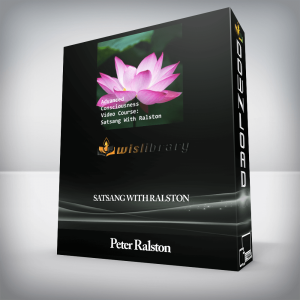Ready to take your recording to the next level? Now you can!The Audio Masterclass Music Production and Sound Engineering Course with both online and downloadable access, complete with world-class textbook materials, audio tutorials, a huge library of audio examples, and enhancement audio and video learning materials.The challenge: To make recordings in your own home studio that are every bit as good as those you hear on CD, download, streaming, radio and TV.The misconception: You don’t have what it takes. You need better gear, you don’t have the ear and you’ll never understand the skills needed to make amazing recordings.The REALITY: If you think that great recording is limited to ‘cool’ producers in million-dollar studios – think again. With the right knowledge and skills YOU can do it. This course will show you how!Gain great skills with great trainingOnline and fully downloadable600-page course manual (online equivalent)1000+ audio example files12 practical assignment projectsStudent advice team supportLearn at your own pace – spread your course out over up to one full year of online access if you wish.Learn from the course when and where you likeAvailable worldwide (we have students in more than 120 countries)Your Audio Masterclass online Student ID (you can use this to seek discounts on software and equipment)30-day full-refund, no-quibble guaranteeTwelve modules – everything you need in audio from start to finishAnalog and digital audio basicsMicrophonesMicrophone preamplifiersEqualizationCompressionRecording softwareReverb and effectsSynthesis and samplingRecording techniquesMixingMasteringMarketing your music and recording servicesHow you will learn in your courseThe Audio Masterclass Music Production and Sound Engineering Course works by online distance learning. We have students in more than 120 countries all around the world. All you need to come on the course is a basic home studio setup and an internet connection, and of course a strong desire to produce recordings of fully professional quality in your own home studio.With Audio Masterclass, you will learn basic studio techniques, mixing and creative recording. Following completion of your course you can progress to enroll in one of our Professional Courses such as Equalization, Compression, Reverb & Effects, Mixing or Mastering.Tutorials and videosCourse instruction is through world-class online textbook materials, audio tutorials, and supplementary video materials where appropriate. We show you the important techniques of audio that professionals use every day, and you can use yourself in your own home studio. All of the course materials are available online, and also enhancement learning materials including videos shot at Abbey Road Studios 2 and 3. You can print, save or download all of your course materials as you wish to keep permanently.Audio examplesOur tutorials and videos are supported by a wealth of audio examples, which are also online and downloadable. We recommend that you load these examples into your digital audio workstation so that you can listen to them in exactly the same way as when you’re recording yourself.Many of the audio examples will show you what you should aim to achieve, whether the topic is EQ, compression, mixing, mastering etc. Others will show you how things can go wrong – and we’ll show you clearly the difference between good audio and bad, and explain the reasons why.Practical projectsThe best way to learn audio is to *do* audio – recording, editing, processing, mixing and mastering. And don’t forget the importance of close, attentive listening. The more you do it, the better you’ll get.So the Audio Masterclass Music Production and Sound Engineering Course features a range of practical projects relating to the modules of the course. The practical projects will set you a task to complete, show you how to do it and point out what could go wrong. And when you have completed your project, you can compare your work with our examples – many of which are created by Audio Masterclass students.Student advice teamAll Audio Masterclass students have access to our Student Advice Team for one full year of enrollment. You can ask questions on any of the course topics and receive a personal response.FlexibilityBecause you have all of your course materials immediately in your hands after enrollment you can learn entirely at your own pace. There is no set schedule and you can move quickly or slowly through the course as you wish and take breaks at any time.Online enrollmentYour Audio Masterclass online enrollment will be valid for one full year. Naturally course materials that you download are yours to keep permanently.Our experience in audio educationAudio Masterclass has experience in audio education going back to 1986. We have been running online courses since 2001 which is longer than any other audio training provider on the web.SummaryAt Audio Masterclass we want to give you the fastest, most effective route towards a professional standard of work in your own home studio – a standard that is fully equal to professional studios and commercial releases.We do this through effective, comprehensive instruction through tutorials and/or videos, audio examples, and practical projects that relate closely to real-world professional practice.If you want to make fast progress, then Audio Masterclass is here to help.What you will learn in your courseModule 01: Analog and Digital AudioModule content: Analog audio: signals, frequency response, noise, distortion, wow & flutter, clicks and interference. Digital audio: analog-to-digital conversion, sampling, quantization, dither, digital-to-analog conversion. Sound isolation: sound isolation methods, practical sound isolation techniques for home and small recording studios, vocal booths. Acoustic treatment: background to room acoustics, acoustic treatment, porous absorption. membrane and panel absorbers, diffusion. Recording studio configuration: recording room, control room. Introduction to essential audio electronics.Assignment 1 – Diagnostic Recording of Speech: It may seem straightforward to make a simple recording of speech, but actually speech is the most difficult sound to record well. It shows up every possible fault and flaw of recording technique, and any background noise or excessive ambience shows up painfully in the gaps between words. We will give you detailed advice, and show you both good and bad examples with clear explanations that will allow you to pinpoint any problems and advise you how to eliminate them from your future recordings.Module 02: MicrophonesModule content: Principle of operation: dynamic, capacitor, piezo, ribbon, electret. Polar patterns: omnidirectional, cardioid, supercardioid, hypercardioid, figure-of-eight. Interference tube microphone. Parabolic reflector microphone. Multipattern microphone. Phantom power, pad, high-pass filter. Microphone techniques: microphone selection, positioning, stereo microphone techniques, coincident crossed pair, near-coincident crossed pair, ORTF, spaced omni.Assignment 2 – Recording Instruments: Make a clean, professionally-finished recording of three instruments or sound sources. Compare two or more microphones, or – if you only have one microphone – compare microphone positions. We want you to learn how to create crystal-clear recordings that demonstrate your microphones well and show a professional polish. This assignment will help you understand which microphone to use for any voice or instrument, and why.Module 03: Microphone PreamplifiersModule content: The need for microphone preamplification, microphone input, line input, instrument input, principle of operation, transistors, vacuum tubes, the need for balancing, transformer balancing, electronic balancing, working with balanced and unbalanced lines, preamplifier operation, gain, output level, phantom power, phase, pad, high-pass filter.Assignment 3 – Polar Patterns and Stereo Configurations: Every recording engineer should carry out this test, but few ever do. All microphones have a ‘polar pattern’ which defines their sensitivity and frequency balance in different directions around the mic. There are also several different important configurations for recording stereo with two microphones. According to how many mics you have available, we will ask for a polished, professional demonstration of your mic’s polar pattern, or the most important stereo configurations.Module 04: EqualizationModule content: Types of equalizer, graphic EQ, parametric EQ, console-style EQ, filters, low-pass filter, high-pass filter, band-pass filter, all-pass filter, notch filter, filter parameters: cut-off frequency, slope, equalizer parameters: frequency, gain, bell/shelf, Q/bandwidth.Assignment 4 – Listening and Equalization: Just as a musician needs a fine sense of pitch, a recording engineer or producer needs a highly-developed sense of EQ. Skill with equalization doesn’t come naturally – it has to be learned. Being able to identify EQ problems is a vital skill, and also being able to enhance voices and instruments with EQ, and help them blend together in the mix. This assignment will help your ears learn to recognize, understand, correct and enhance the frequency balance of a recording.Module 05: CompressionModule content: The need for compression. Dynamic range control. Subjective enhancement. Compression parameters: ratio, threshold, attack, release, knee, stereo link. Operating principles: variable-mu, FET, diode bridge, optical, VCA. Side chain principles and operation: de-essing.Assignment 5 – Demonstrations of Compression: Compression is used to control dynamic range, and also to give a recording presence and ‘sparkle’. In this assignment we will ask you to demonstrate your skills with compression on female and male vocal, a full drum set and individual drum instruments, a full mixed recording, and a full orchestral recording with severe dynamic range problems. In your finished work we will advise you how to achieve a professional standard of presentation.Module 06: Recording SoftwareModule content: Disk recording principles. The disk recording medium: rotational speed, seek time, fragmentation, input/output assignment. Recording, editing and crossfade editing, gain change and normalization, mixing, inserts, auxiliary sends, auxiliary tracks, busses, faders and master fader, levels, decibels, dB and dBFS, headroom.Assignment 6 – Creation of a Drum Track: We will ask you either to make an interesting and creative drum track from samples, and give it the characteristic texture of sampled and looped drums. Alternatively, if you have a high-quality drum virtual instrument available, we will ask you to recreate some actual professional drum playing. That’s a challenge!Module 07: Effects & Plug-insModule content: Delay, single echo, spin echo, spin echo with positive feedback, reverberation, acoustic and electro-acoustic reverberation: chamber, spring, plate, tape, digital, algorithmic reverberation, convolution reverberation, phasing, flanging, chorusing, pitch change and correction, harmonic generation and aural enhancement, comparison between manual effects, hardware effects and plug-ins.Assignment 7 – Natural Reverberation Chamber: In this assignment you will set up a loudspeaker and a microphone in a reverberant space, perhaps your bathroom or stairwell, and send a dry signal to it. The microphone will pick up the reverberation of the space. Using this technique you can create reverberation that is far more natural and interesting than any plug-in. What’s more it’s unique because no-one else has access to the same reverberant space as you.Module 08: Synthesis & SamplingModule content: Types of synthesis: additive, subtractive, FM, wavetable, physical modeling. Subtractive synthesis components: voltage-controlled oscillator, voltage-controlled filter, voltage-controlled amplifier, envelope generator. Sampling: looping, multisampling, phrase sampling, key groups, velocity layers, mute groups.Assignment 8 – Technical Creativity: In this amazing project you will create a piece of music using only a sine wave and white noise as source material. This is a real challenge of both technical and musical creativity. We want you to create sounds that you couldn’t possibly have expected – and a great original piece of music. If you are more technical than musical, we’ll ask you to create an imaginative non-musical soundscape. That’s a challenge too.Module 09: Recording TechniquesModule content: Vocals: microphone selection, microphone positioning, acoustic screens and vocal booths, foldback, headphone types, use of headphone amplification, loudspeaker foldback, how the engineer monitors foldback. Drums: drum set up for recording, microphone selection for drums and cymbals, single microphone technique, twin microphone technique for basic stereo, the ‘Recorderman’ doubly-equidistant two-microphone configuration, the ‘Glyn Johns’ method, full individual miking with overheads. Acoustic guitar: microphone selection and positioning. Electric guitar, piano, string instruments, wind instruments, percussion instruments, small groups and ensembles, orchestral recording. Session management for ensembles, orchestras and choirs. Multitrack recording. Studio setup, foldback, monitoring. Compilation, punch-in. Production techniques for vocalists and instrumental performers.Assignment 9 – Voice or Instrument Production: In this assignment you will be given a female vocal recorded in Abbey Road Studio 3 and a skeleton backing track. We will ask you to devise an instrumental accompaniment and record it. More than a just simple, clear recording, we will ask you to create an imaginative ‘produced’ sound using whatever software or equipment you have available. We want what you do to be amazing.Module 10: MixingModule content: Analog mixing consoles: overview, channels, groups and sub-groups, master section, VCA faders. Console monitoring: split, inline, all-input. Foldback, communications, external inputs. Channel functions: mic inputs, line inputs, insert point, equalization, dynamics, auxiliary sends, pan, mute and mute groups, PFL/AFL/solo, fader. Mixing console automation. Digital mixing consoles. Comparison between digital and analog consoles. Assignable consoles. Automation and recall. Mixing procedures and techniques.Assignment 10 – Mixing: In this assignment you will be given a complete multitrack recording of an amazing rock music track to mix. The multitrack, in WAV format which can be imported into any DAW, includes drums, electronic drums, bass guitar, rhythm guitars, lead guitar, organ, background vocals, lead vocal and vocal double. The assignment includes full guidance on how to approach the project and stage-by-stage blend the instruments and vocals into a perfect release-ready mix.Module 11: MasteringModule content: The need for mastering. Correction of faults. Mastering for vinyl. Improvement of stereo mixes. Matching tracks for albums and compilations. Subjective loudness and the ‘loudness war’. Equalization. Compression. Limiters and look-ahead limiters. Multi-band compression. Intersample peaks. LUFS.Assignment 11 – Mastering: For this assignment we have a professionally-produced finished master, and also the original unmastered mix, for you to listen to. Then we will ask you to create your own master from the basic mix. The assignment includes detailed advice on all of the processes of mastering such as fault correction, topping and tailing, equalization, compression, harmonic generation, limiting and protection against intersample peaks.Module 12: Marketing Your Music & Recording ServicesModule content: Industry roles: record producer, recording engineer, A&R manager, studio manager, session musician, arranger, programmer. Industries: music, recording, record labels, broadcasting, radio, television, film, events, the internet. Pitching and promoting your services as an artist, engineer or producer. Showreel guidance.Assignment 12 – Your Industry Standard Showreel: In this assignment you will create your own ‘showreel’. Every industry professional has a showreel that they use to demonstrate what they can do to potential clients. At the end of this module, you will have your own showreel that looks and feels like that of a top pro. You can create a CD or DVD, YouTube video or SoundCloud playlist. You can even create an entire website if you wish. But however you choose to demonstrate your abilities, we will demand total professionalism, so that for anyone who listens your showreel it is indistinguishable from that of a seasoned industry insider.Highlights from a selection of our videos…This course is for you if…You listen to pro recordings and think to yourself, “Why don’t mine sound like that?”You want to master all of the techniques of the recording studioYou want to get the utmost out of your equipment and softwareYou want to save money by realizing it’s all down to your knowledge, skills and experience – you don’t need more equipment or softwareYou want to be sure that your production skills allow you to get the best from your musical creativityGet Music Production And Sound Engineering Course – David Mellor, Only Price $52Tag: Music Production And Sound Engineering Course – David Mellor Review. Music Production And Sound Engineering Course – David Mellor download. Music Production And Sound Engineering Course – David Mellor discount. music production software. music production courses. music production schools. music production software free. music production desk. music production equipment. music production apps
Music Production And Sound Engineering Course – David Mellor
₹7,968.00







